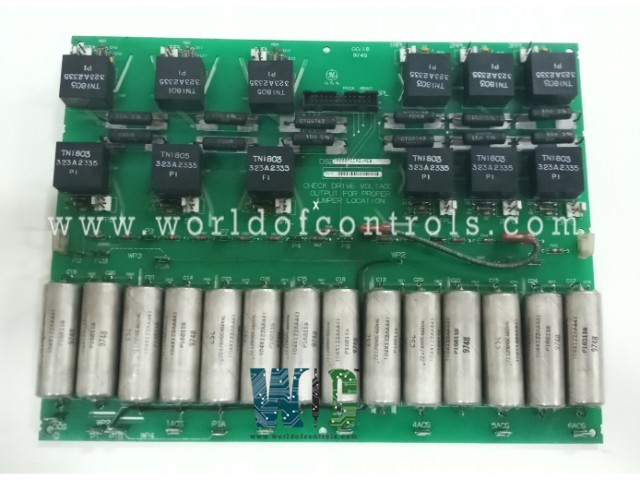SPECIFICATIONS
Part No.: IS230PCCAH1A
Manufacturer: General Electric
Country of Manufacture: United States of America (USA)
Fault detection: Incorrect ID chip
Operating Temperature: -30 to 65 oC
Technology: Surface mount
Number of channels: 8 channels
Thermocouple type:s E, J, K, S, T
Product Type: Core Analog I/O module
Availability: In Stock
Series: Mark VIe
Functional Description
IS230PCCAH1A is a Core Analog I/O module developed by GE. It is a part of Mark VIe control system. The module, along with its associated Core Analog terminal boards, provides a significant portion of the analog signal input/output (I/O) required for engine operation. These terminal boards facilitate the connection of various analog signals to the control system. The module serves as the electrical interface between one or two Ethernet I/O networks and the terminal board. This interface allows for the seamless transmission of analog signals between the control system and the engine.
Processor Features
- High-Speed Processor with RAM and Flash Memory: The processor board is equipped with a high-speed processor that handles the computation and processing tasks required for control operations.It includes RAM (Random Access Memory) for temporary data storage and quick access during processing. Flash memory is provided for storing firmware and other essential data, ensuring persistent storage even when the power is off.
- Ethernet Ports: The board features two fully independent 10/100 Ethernet ports, each with its connector. These ports facilitate high-speed communication and data transfer between the module and the Ethernet I/O networks. The independence of the Ethernet ports ensures redundancy and enhances reliability, allowing for continuous operation even if one port fails.
- Hardware Watchdog Timer and Reset Circuit: A hardware watchdog timer is included to monitor the processor's operation. If the processor fails to execute code correctly within a specified time frame, the watchdog timer triggers a system reset, ensuring system stability. The reset circuit helps in maintaining reliable operation by resetting the system in case of errors or malfunctions.
- Internal Temperature Sensor: An internal temperature sensor monitors the temperature of the processor board, ensuring it operates within safe limits. This helps in preventing overheating and potential damage to the board.
- Status-Indication LEDs: The board includes status-indication LEDs that provide visual feedback on the operational status of the processor board. These LEDs help in quickly diagnosing issues and confirming normal operation.
- Electronic ID and Ability to Read IDs on Other Boards: The processor board contains an electronic ID that uniquely identifies it within the system. This ID is used for system management and diagnostics. Additionally, the board can read electronic IDs on other connected boards, facilitating system integration and management.
- Input Power Connector with Soft Start/Current Limiter: The input power connector on the board includes a soft start feature, which gradually ramps up the power supply to prevent sudden surges that could damage the components. A current limiter is also included to protect the board from excessive current, enhancing its durability and reliability.
- Local Power Supplies with Sequencing and Monitoring: The processor board is equipped with local power supplies that provide the necessary voltages for its operation. These power supplies include sequencing features that ensure the correct order of power application, which is critical for the proper startup of the board. Monitoring capabilities are also included to track the health and status of the power supplies, ensuring they are functioning correctly.
Auto-Reconfiguration
- The Auto-Reconfiguration feature is an advanced capability that enhances the usability and maintenance of the Mark VIe control system. Introduced with the ControlST* V03.05 software release, this feature significantly simplifies the process of replacing I/O packs or modules within the system.
- Auto-reconfiguration allows I/O packs to be replaced without requiring manual intervention for reconfiguration. This reduces downtime and simplifies maintenance procedures, making it easier for operators to manage the control system. When the controller detects an I/O pack booting with a configuration different from what is currently in use, it automatically initiates a reconfiguration process. This ensures that the new or replaced I/O pack is immediately updated to match the existing system configuration.
- During the reconfiguration process, the controller downloads a reconfiguration file to the I/O pack. This file includes all necessary components such as bootload, baseload, firmware, and specific parameters. This comprehensive update ensures that the I/O pack operates seamlessly within the existing control system. Each I/O pack is updated to the current configuration being used by the controller, ensuring consistency across the control system and preventing issues that might arise from configuration mismatches.
- The system also checks whether the I/O pack already contains the latest version of the configuration. If the I/O pack is already up-to-date, no further action is taken. This feature prevents unnecessary updates and ensures that only needed changes are applied. This process involves detecting the I/O pack, initiating the reconfiguration, downloading the necessary file, updating the I/O pack, and verifying its operation with the correct and current configuration.
The WOC team is always available to help you with your Mark VIe requirements. For more information, please contact WOC.
Frequently Asked Questions
What is IS230PCCAH1A?
It is a Core Analog I/O module developed by GE under the Mark VIe series.
What components are included in the reconfiguration file?
The reconfiguration file includes the bootload, baseload, firmware, and specific parameters required for the I/O pack to operate correctly within the control system.
How does the system ensure the I/O pack is up-to-date?
The system checks whether the I/O pack already contains the latest version of the configuration. If the I/O pack is up-to-date, no further action is taken. This prevents unnecessary updates and ensures that only needed changes are applied.
What happens if the I/O pack already has the latest configuration?
If the I/O pack already contains the latest configuration, the system will not perform any updates, thus preventing redundant actions and ensuring efficient operation.
